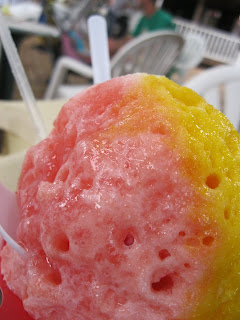 A light tea that was served at the table, with crushed pistachios and almonds added in, giving it a nice crunch as you drank it. A pinkish colour, and a yogurty flavour, and a hint of rose water and cardamom. Pretty awesome.
A light tea that was served at the table, with crushed pistachios and almonds added in, giving it a nice crunch as you drank it. A pinkish colour, and a yogurty flavour, and a hint of rose water and cardamom. Pretty awesome.On Kashmiri tea (from ellenskitchen.com)
Kashmiris make two or three types of tea using special equipment, called a "samovar", and many say good kashmiri tea has to be made in a samovar.
One type of tea is called shi:r' cha:y or shirchai. This type is made with a slightly fermented tea such as an oolong. It is brewed with bicarbonate of soda, salt, whole milk, and cream (mala:y), spices and pistachios. It has a very pleasant pinkish or peachy color. Shi:r' cha:y also is a typically Kashmiri tea, but not every visitor likes it. Salt tea is served at evry breakfast and in the afternoon. It resembles the butter tea of Tibet. Kashmiri folk say the salt is refreshing in the heat; in Mongolia and Tibet, tea is salted to resist the cold!
Kashmiri tea is best enjoyed in a Kashmiri kho:s (cup): it used to be served in bronze Cups by Pandits or handleless porcelain Bowls, (K -'Chin Pyala'.) by Muslims.















